Canon EOS 33 Operating Instructions
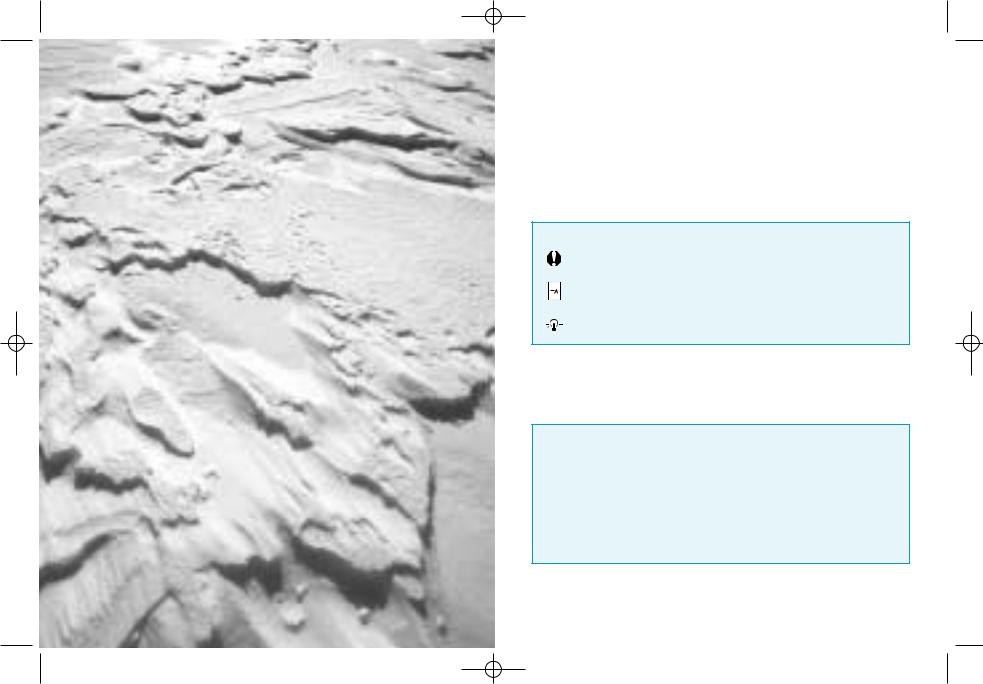
D33 K127 All.qxd 21-7-00 15:01 Page 2
Thank you for purchasing a Canon product.
The EOS 33/ELAN 7 is a high-performance, AF single-lens reflex camera with seven focusing points.
Its many features can suit a wide variety of subjects and shooting conditions. Camera operation can be fully automatic or you can use the semi-automatic or manual modes to obtain the desired effects.
Before using your new camera, read this instruction booklet to familiarize yourself with the camera.
Symbols
The Caution symbol alerts you to actions to prevent picture-taking problems.
 The Note symbol gives supplemental information for basic camera
The Note symbol gives supplemental information for basic camera

 operation.
operation.


 The Light bulb symbol offers helpful tips for operating your camera
The Light bulb symbol offers helpful tips for operating your camera
 or taking pictures.
or taking pictures.
Also read “Handling Cautions” on page 6 to prevent camera malfunction and damage.
Keep this instruction booklet handy for easy reference.
Before Using Your Camera
•Before shooting an important event, be sure to take test shots to make sure the camera operates properly.
•EOS cameras have a lens mount for dedicated operation (autofocusing, exposure control, etc.) with Canon EF lenses. Using a non-Canon EF lens with an EOS camera may not result in proper camera or lens operation.
Note that the warranty does not cover any camera malfunction or damage occurring with the use of non-Canon products.
3
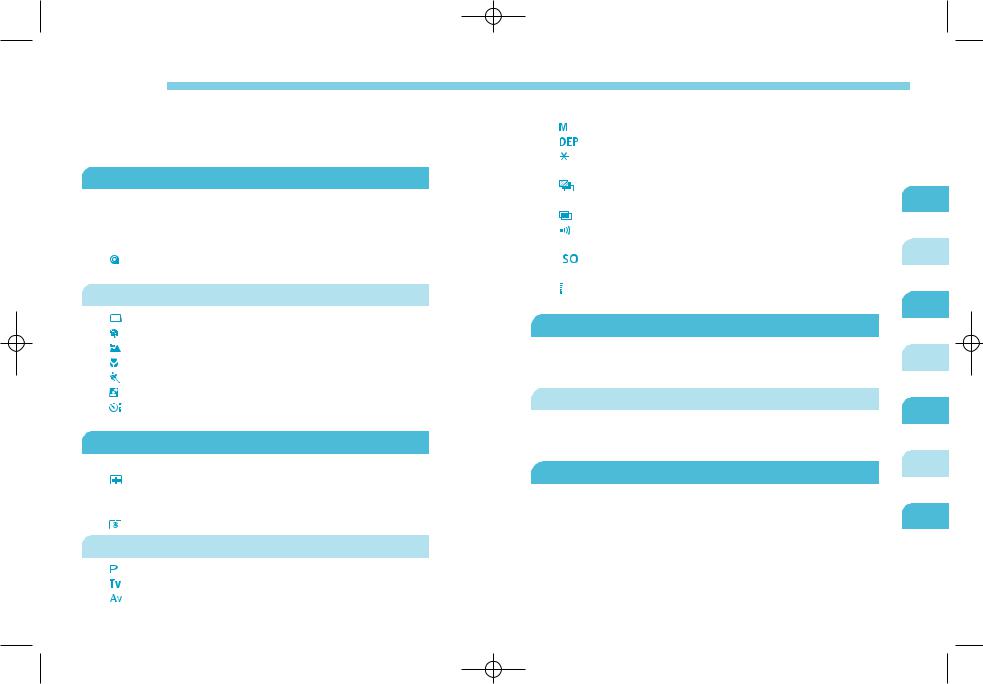
D33 K127 All.qxd 21-7-00 15:01 Page 4
Contents
Handling Cautions ..................................................................... |
6 |
Quick Start Guide ...................................................................... |
8 |
Nomenclature .......................................................................... |
10 |
Conventions Used in this Instruction Booklet .......................... |
16 |
1 Before You Start .............................................................. |
17 |
Installing the Batteries and Checking the Battery Level .......... |
18 |
Mounting and Detaching a Lens.............................................. |
20 |
Dioptric Adjustment ................................................................. |
21 |
How the Shutter Button Works ................................................ |
22 |
Loading and Unloading Film ............................................... |
23 |
Holding the Camera ................................................................ |
26 |
2 Fully Automatic Shooting ............................................... |
27 |
Full Auto Mode................................................................... |
28 |
Portrait Mode ...................................................................... |
32 |
Landscape Mode................................................................ |
33 |
Closeup Mode..................................................................... |
34 |
Sports Mode ....................................................................... |
35 |
Night Scene Mode .............................................................. |
36 |
Using the Self-timer ........................................................... |
37 |
Imprinting the Date or Time (QD Model only).......................... |
39 |
3 AF Modes and Metering Modes...................................... |
41 |
Selecting the AF Mode ............................................................ |
42 |
Selecting a Focusing Point ................................................ |
45 |
Focusing Off-Center Subjects ................................................. |
47 |
When Autofocus Fails ............................................................. |
48 |
Metering Modes ................................................................. |
49 |
4 Creative Zone Modes....................................................... |
51 |
Program AE ........................................................................ |
52 |
Shutter-Speed Priority AE.................................................. |
54 |
Aperture-Priority AE........................................................... |
56 |
4
|
|
Contents |
||
Depth-of-field Preview ............................................................. |
57 |
|
||
|
Manual Exposure ................................................................ |
58 |
|
|
|
Depth-of-Field AE............................................................ |
60 |
|
|
|
AE Lock .............................................................................. |
63 |
|
|
Exposure Compensation ......................................................... |
64 |
|
||
|
Auto Exposure Bracketing (AEB) ...................................... |
65 |
1 |
|
Bulb Exposures ....................................................................... |
67 |
|||
|
Multiple Exposures ............................................................ |
68 |
|
|
|
Silencing the Beeper .......................................................... |
69 |
|
|
Mirror Lockup .......................................................................... |
70 |
2 |
||
|
Setting the ISO Film Speed |
71 |
||
|
||||
Selecting the Film Advance Mode........................................... |
71 |
|
||
|
Wireless Remote Control...................................................... |
72 |
3 |
|
Using the Remote Switch |
72 |
|||
|
||||
5 Flash Photography .......................................................... |
73 |
|
||
Using the Built-in Flash ........................................................... |
74 |
4 |
||
Flash Photography with an EX-Series Speedlite..................... |
77 |
|||
Using Other EOS-Dedicated Speedlites ................................. |
84 |
|
||
6 Custom Functions ........................................................... |
85 |
5 |
||
Setting a Custom Function |
86 |
|||
|
||||
Canceling a Custom Function ................................................. |
87 |
|
||
Custom Function List............................................................... |
88 |
6 |
||
Reference ......................................................................... |
90 |
|||
Basic Photography Terms ....................................................... |
90 |
|
||
Feature Availability Table ........................................................ |
92 |
Reference |
||
Program Line |
94 |
|||
|
||||
Exposure Warning List ............................................................ |
95 |
|
||
Troubleshooting Guide ............................................................ |
96 |
|
||
Major Accessories ................................................................... |
97 |
|
||
Major Specifications ................................................................ |
99 |
|
||
Index...................................................................................... |
102 |
|
||
|
|
|
5 |
|
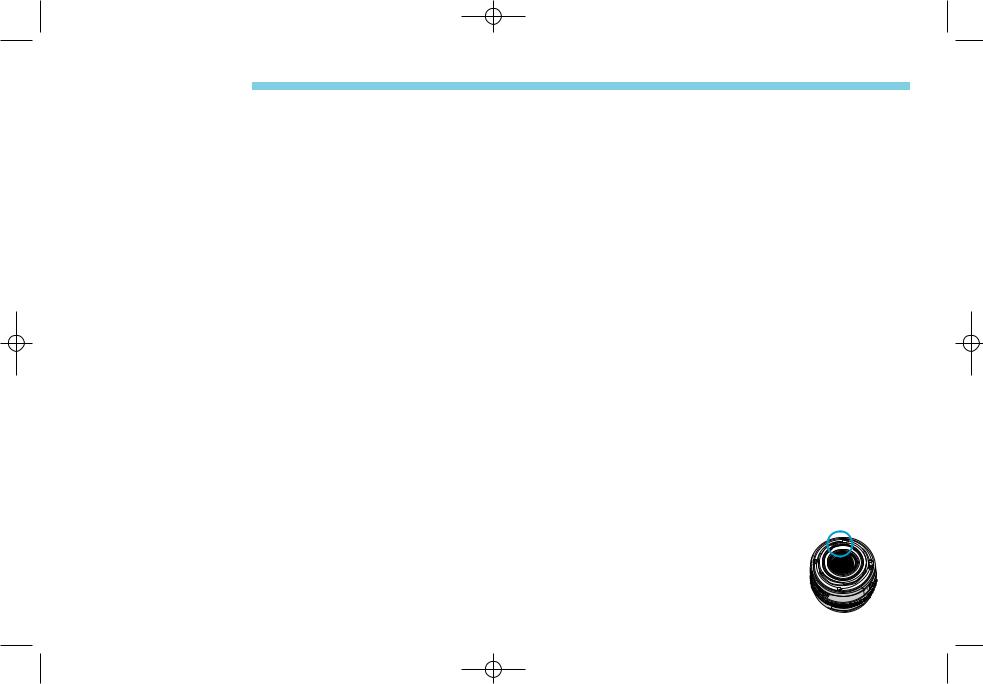
D33 K127 All.qxd 21-7-00 15:01 Page 6
Handling Cautions
Camera Care and Storage
(1)The camera is a precision instrument. Do not drop it or subject it to physical shock.
(2)This camera is not waterproof and cannot be used underwater. If the camera gets really wet, promptly consult your nearest Canon Service Center. Wipe off any water droplets with a dry cloth. If the camera has been exposed to salty air, wipe with a well-wrung damp cloth.
(3)Do not leave the camera in places prone to excessive heat such as in a car on a sunny day. Excessive heat can cause the camera to malfunction.
(4)The camera contains precision electronic circuitry. Never attempt to disassemble the camera.
(5)Use only a blower brush to blow away dust on the lens, eyepiece, mirror, focusing screen, and film compartment. Do not clean the camera body or lens with a cleaner containing an organic solvent. For stubborn dirt, consult your nearest Canon Service Center.
(6)The shutter curtains are extremely thin. Use only a blower to clean them. Be careful not to blow air too forcefully on the shutter curtains. The shutter curtains can be easily deformed or damaged. Also, when loading and unloading film, be careful not to touch the shutter curtains.
(7)Do not touch the electrical contacts with your fingers. Otherwise corrosion may develop on the contacts, resulting in improper camera operation.
(8)If the camera is not to be used for an extended period, remove the battery. Store the camera in a well-ventilated, cool, dry place. During the storage period, press the shutter button to release the shutter a few times once in a while.
(9)Avoid storing the camera in a laboratory, cabinet, etc., where corrosive chemicals are present.
(10)If the camera has not been used for an extended period or if the camera is to be used for an important event, check the operation of all the camera controls or take it to your nearest Canon Service Center for inspection.
(11)After detaching the lens from the camera, put on the lens caps or put down the lens with the rear end up to avoid scratching the lens surface and electrical contacts.
(12)Even when the Main Switch is set to <  >, a small amount of power is still supplied to the camera’s LCD panel. However, this does not affect the number of film rolls which can be taken with the battery.
>, a small amount of power is still supplied to the camera’s LCD panel. However, this does not affect the number of film rolls which can be taken with the battery.
6
Handling Cautions
LCD Displays
In time, the camera’s LCD panel display and the LCD display in the viewfinder may fade and become difficult to read. If this happens, have it replaced (at cost) by a Canon Service Center.
At low temperatures, the LCD display response may become slower. And at 60ÞC or higher temperatures, the display may blacken. In either case, the display will return to normal at room temperature.
Lithium Batteries
(1)The camera operates on two CR123A lithium batteries. Check the battery level in the following cases (Æpage 18):
•After replacing the batteries.
•After not using the camera for an extended period.
•The shutter stops working.
•The camera is being used in a low-temperature environment.
•You will be shooting an important event.
(2)Before installing the batteries, wipe the battery contacts to remove any fingerprints and smudges. This is to prevent faulty connections and corrosion.
(3)Never disassemble or recharge the batteries. Also, never store a battery in high-temperature places or short circuit the battery contacts or toss a battery into a fire.
(4)Although the batteries work well even at low temperatures, battery performance may decline slightly at freezing temperatures. In such a case, keep spare batteries warm in a pocket, etc., and use and warm the batteries alternately.
How Low Battery Levels Affect Camera Operation
On the LCD panel, if the <  > icon blinks or it is not displayed, a proper exposure can still be obtained as long as the shutter releases. However, when the battery level is low, film advance and auto rewind might stop midway or not work at all and <
> icon blinks or it is not displayed, a proper exposure can still be obtained as long as the shutter releases. However, when the battery level is low, film advance and auto rewind might stop midway or not work at all and <  > may blink on the LCD panel. After the batteries are replaced with new ones, film advance will be possible and film rewind can resume by pressing the <
> may blink on the LCD panel. After the batteries are replaced with new ones, film advance will be possible and film rewind can resume by pressing the <
 > button.
> button.
 Contacts
Contacts
Lens Electrical Contacts
After detaching the lens from the camera, put on the lens caps or put down the lens with the rear end up to avoid scratching the lens surface and electrical contacts.
7
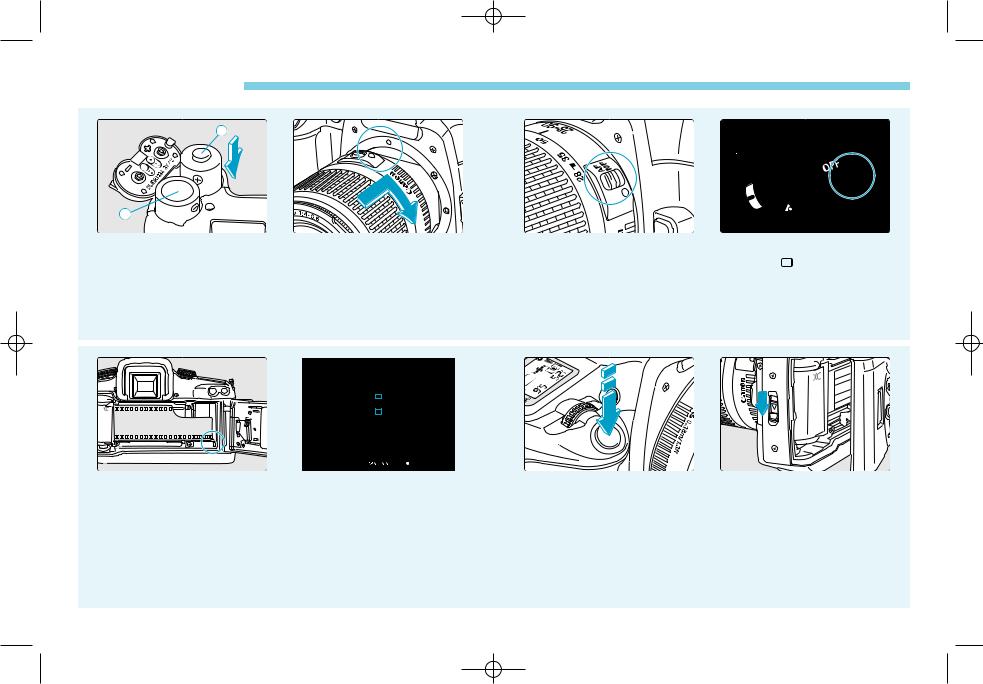
D33 K127 All.qxd 21-7-00 15:01 Page 8
Quick Start Guide
+
– |
|
Install the batteries. |
Attach a lens. |
Refer to the battery |
Align the red dots on the |
orientation diagram on the |
lens and camera and turn |
1 battery chamber |
2the lens as shown by the |
and insert two CR123A |
arrow until it snaps in |
lithium batteries |
place. (®page 20) |
Load the film. |
|
Focus the subject. |
Align the edge of |
film |
Aim the focusing points on |
leader with the orange |
the main subject and press |
|
5mark on the camera and |
6the shutter button halfway |
|
close the camera |
until |
to autofocus. (®page 22) |
it snaps shut. (® |
23) |
• Under low-light or backlit |
• The film will then |
|
conditions, the built-in |
advance to the first |
flash will pop-up and fire |
|
frame automatically. |
automatically. (®page 74) |
|
8
Quick Start Guide
3 |
On the lens, set the |
Turn the Command Dial |
focus mode switch to |
to < > (Full Auto). |
|
<AF>. |
Keep pressing the |
|
(®page 20) |
4Command Dial’s lock |
button while turning the dial. (®page 28)
7 Take the picture.
Press the shutter button completely to take the picture. (®page 22)
Unload the film.
At the end of the roll, the film rewinds automatically. Open the camera back to remove the film cartridge. (®page 25)
9
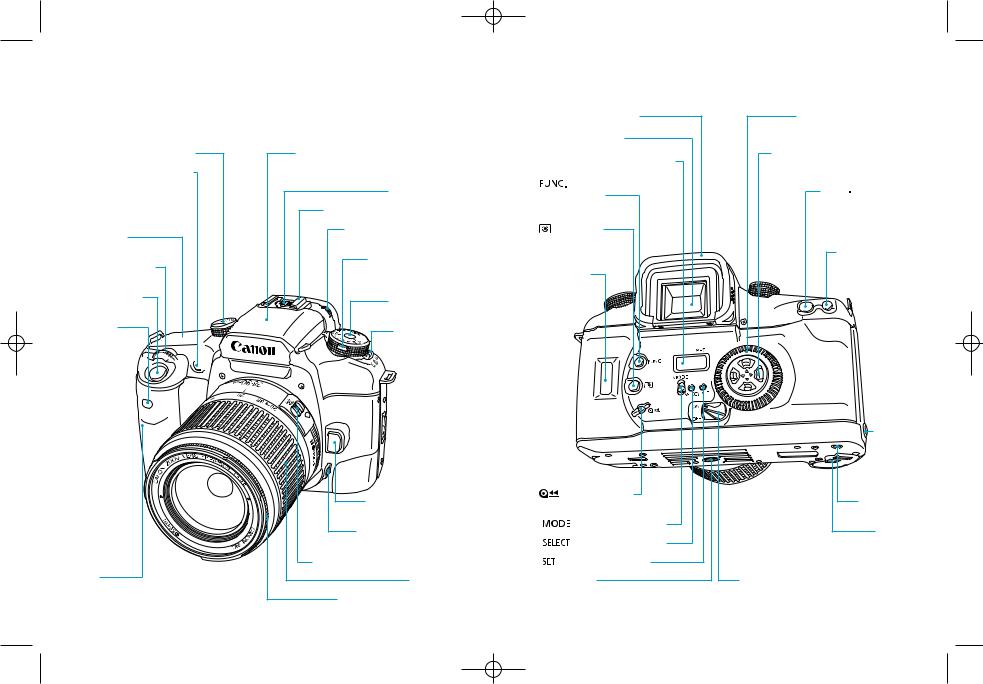
D33 K127 All.qxd 21-7-00 15:01 Page 10
Nomenclature 
• The reference is indicated in parentheses.
• The camera controls are indicated as icons in brackets < >.
AF mode dial (®page 15)
Red-eye reduction lamp / Self-timer lamp / Wireless remote control operation lamp
(®page 30 / 37 /
LCD panel (®page 12)
<  > Main Dial (®page 16)
> Main Dial (®page 16)
Shutter button (®page 22)
Wireless remote 
 control sensor
control sensor 
 (®page 72)
(®page 72) 

Grip
(battery chamber) (®page 18)
10
Built-in flash (retracted) (®page 74)
AF-assist light (®page 30)
X-sync contact
Hot shoe (®page 74, 87, 97)
Dioptric adjustment knob (®page 21)
Command Dial lock release button (® page 14)
Command Dial
(®page 14)
Film advance
mode lever (®page 15,37,71)
 Strap eyelet (®page 17)
Strap eyelet (®page 17)
 Camera
Camera
back lever (®page 23)
Lens release button (®page 20)
Depth-of-field preview button (®page 57)
Focus mode switch (®page 20)
Zoom ring
Focusing ring (®page 48)
Nomenclature
Eyecup (®page 21, 38)
Viewfinder eyepiece
*Date display panel (®page 39) |
|
< |
> |
Function button |
|
(®page 24,31,65,68,69,71,76) |
|
< |
> Metering |
mode button |
|
(®page 49) |
|
Film window |
|
< |
> Midroll rewind |
button (®page 25) |
|
*< |
> button (®page 39) |
*< |
> button (®page 40) |
*< |
> button (®page 40) |
Tripod socket |
|
* QD Model only
<  > Quick Control Dial
> Quick Control Dial
(®page 16)
<  > Focusing point selection key (®page 45)
> Focusing point selection key (®page 45)
<

 > AE lock / FE lock / Custom
> AE lock / FE lock / Custom
Function setting button (®page 63 / 80 / 86)
<  > Focusing point selector (®page 45, 89)
> Focusing point selector (®page 45, 89)
Remote |
control |
terminal |
(®page 72) |
Guide hole |
Battery chamber lever (®page 18)
Quick Control Dial switch (®page 16)
11
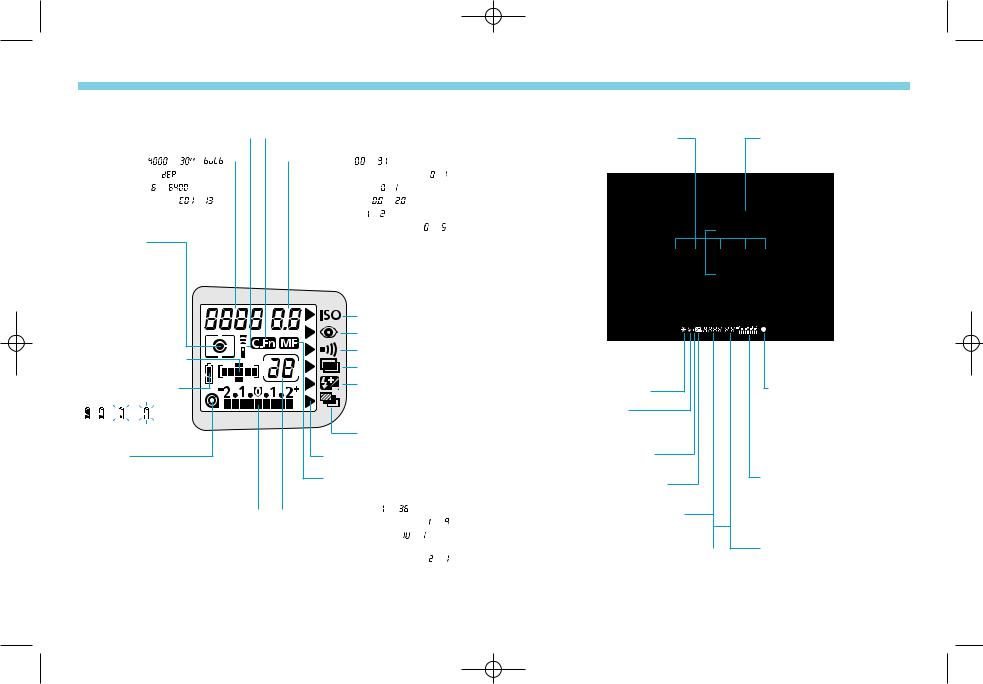
D33 K127 All.qxd 21-7-00 15:01 Page 12
Nomenclature
LCD Panel
Remote control icon |
|
|
|
|
|
|
|
|
Custom Function icon |
|
|
||||
|
|
|
|
|
|
|
|
|
|
||||||
Shutter speed ( |
- |
, |
) |
|
|
|
|
|
Aperture ( |
- |
) |
|
|
|
|
|
|
|
|
|
|
|
|||||||||
Depth-of-field AE ( |
|
|
) |
|
|
|
|
|
|
Red-eye reduction setting ( |
, |
) |
|||
ISO film speed ( |
- |
|
) |
|
|
|
|
|
|
Beeper setting ( |
, |
) |
|
|
|
Custom Function No. ( |
- |
) |
|
|
|
|
|
AEB amount ( |
- |
) |
|
|
|||
|
|
|
|
|
|
|
|
|
|
DEP points ( |
, |
) |
|
|
|
|
|
|
|
|
|
|
|
|
|
Custom Function setting ( |
- |
) |
|||
Metering mode
 Evaluative metering
Evaluative metering
 Partial metering
Partial metering  Centerweighted
Centerweighted
averaging metering
|
ISO film speed icon |
|
|
Red-eye reduction icon |
|
Focusing point selection |
Beeper icon |
|
Multiple exposures icon |
||
(Auto / Manual) |
||
|
||
|
Flash exposure |
|
Battery level (4 levels) |
compensation icon |
|
|
AEB icon |
|
Film status |
Function setting arrow |
|
No film loaded |
|
|
Film rewind completed |
Manual focus icon |
|
Autoloading failed |
|
Exposure level |
|
|
|
Frame counter ( - |
) |
|
|
(up to ±2 stops in 1/2-stop increments) |
|
Multiple-exposure setting ( |
- |
) |
|||
Exposure compensation amount |
|
||||||
|
Self-timer operation ( |
- |
) |
|
|||
AEB range |
|
|
|||||
|
Wireless remote control operation |
||||||
Flash exposure compensation amount |
|
||||||
Red-eye reduction lamp on |
|
|
( |
- |
) |
||
|
|
|
|
|
|||
Film rewind in progress
• The <  > arrow is displayed next to the function being set.
> arrow is displayed next to the function being set.
Nomenclature
Viewfinder Information
Focusing points (superimposed) |
New Lasermatte focusing screen |
AE lock / FE lock indicator
Flash-ready indicator
Insufficient flash warning (during FE lock)
High-speed sync (FP flash) indicator
Flash exposure compensation indicator
Shutter speed ( 


 -
- 

 ,
, 

 )
)
FEL display ( 

 )
)
DEP point display ( 
 -
-  ,
,  )
) 

In-focus indicator
*In AF mode:
Lights when focus is achieved, blinks at 2 HZ when not achieved.
*In MF mode:
Lights when focus is achieved (focusing aid).
Exposure level
(up to ±2 stops in 1/2-stop increments) Exposure compensation amount AEB range
Red-eye reduction lamp-on indicator
Aperture display ( 
 -
- 
 )
)
•On pages 12 and 13, all the display items are shown for explanatory purposes. During actual operation, only some of the items are displayed.
12 |
13 |
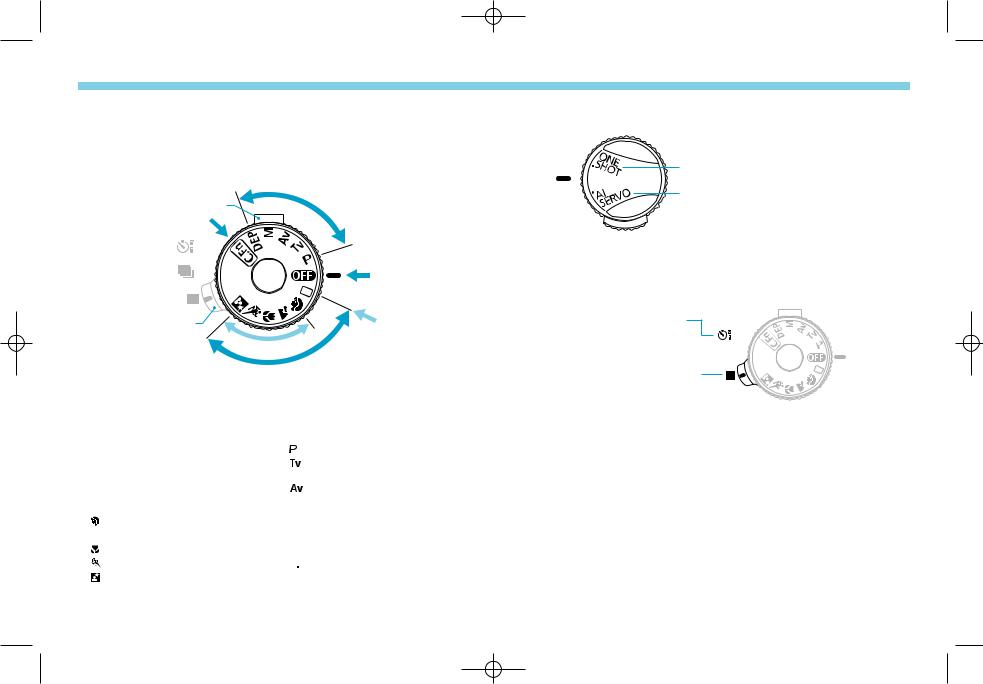
D33 K127 All.qxd 21-7-00 15:01 Page 14
Nomenclature
Command Dial
•The dial is divided into four zones.
•The dial is locked when it is set to <  >. To release the lock, hold down the Command Dial lock release button and turn the dial.
>. To release the lock, hold down the Command Dial lock release button and turn the dial.
|
|
C |
re |
|
|
|
|
ati |
|
Command Dial |
|
|
|
v |
|
|
|
e Z |
|
lock release button |
|
|
|
o |
|
|
|
e |
|
|
|
|
|
n |
Custom Function Set |
|
|
|
|
|
|
|
|
OFF |
Film advance mode lever |
|
|
|
Full Auto mode |
g |
r |
|
a |
|
|
m |
|
||
C |
|
ammed I |
e |
|
|
ontrol Zon |
|
||
|
|
|
ic |
Z |
|
|
Bas |
|
|
1Basic Zone
Basically, all you do is point and press the shutter button.
 : Full Auto (®page 28)
: Full Auto (®page 28)
Fully automatic mode where the camera takes care of everything.
Programmed Image Control Zone
Fully automatic modes for a particular subject.
: Portrait mode (®page 32)
 : Landscape mode (®page 33)
: Landscape mode (®page 33)
: Close-up mode (®page 34)
: Sports mode (®page 35)
: Night Scene mode (®page 36)
2Creative Zone
Semi-automatic and manual modes enable you to take control of the camera to obtain the desired result.
: Program AE (®page 52)
: Shutter speed-priority AE (®page 54)
: Aperture-priority AE (®page 56)
 : Manual exposure (®page 58)
: Manual exposure (®page 58) 
 : Depth-of-field AE (®page 60)
: Depth-of-field AE (®page 60)
3Custom Function Set
 : Custom Function (®page 86)
: Custom Function (®page 86)
4 : Off
: Off
Nomenclature
AF Mode Dial
 ONE SHOT AF (®page 42)
ONE SHOT AF (®page 42)




 AI FOCUS AF (®page 43)
AI FOCUS AF (®page 43)
 AI SERVO AF (®page 44)
AI SERVO AF (®page 44)
Film Advance Mode Lever
Self-timer / Remote control mode (®page 72)
Continuous (®page 71) 

Single-frame (®page 71) 
14 |
15 |
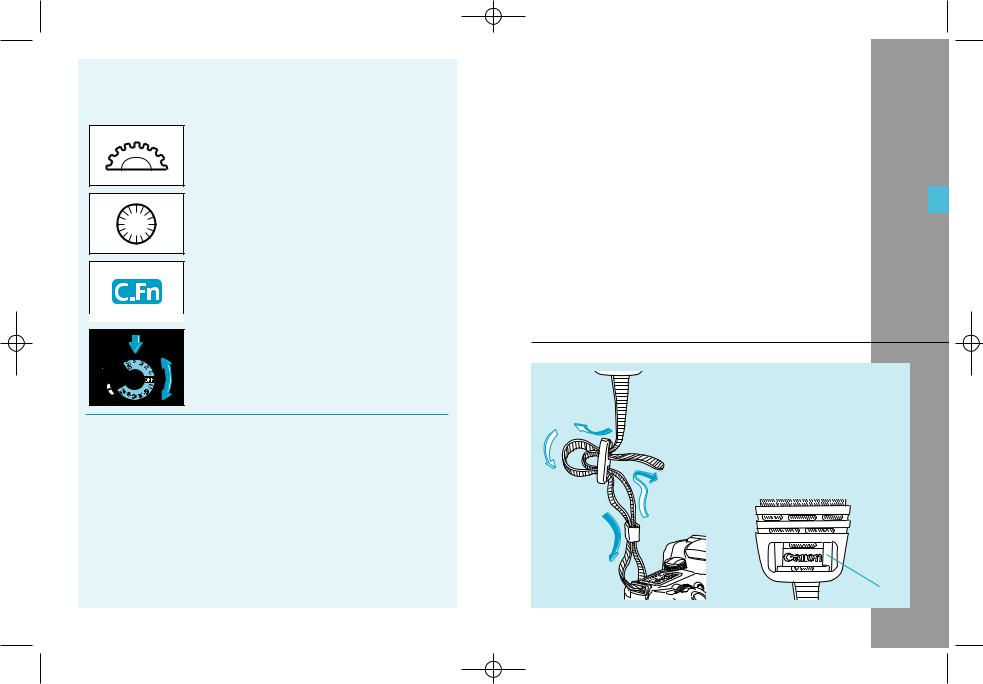
D33 K127 All.qxd 21-7-00 15:01 Page 16
Conventions Used in this Instruction Booklet
•In this booklet, the < > icon indicates the Main Dial.
> icon indicates the Main Dial.
•The <  > icon is the Quick Control Dial. Turn the Quick Control Dial switch to <
> icon is the Quick Control Dial. Turn the Quick Control Dial switch to < > before using the Quick Control Dial.
> before using the Quick Control Dial.
•This symbol indicates that there is a related Custom Function that is described briefly. Detailed descriptions are provided in “Custom Functions” on page 85.
• All the operations described in this booklet assume that the Command Dial is not set to
< >. Before proceeding with any operation, turn the Command Dial to a picture-taking mode by pressing the lock button and turning the dial.
>. Before proceeding with any operation, turn the Command Dial to a picture-taking mode by pressing the lock button and turning the dial.
•Page numbers in parentheses (®page ■) indicate where you can find more relevant information.
•The camera control icons and markings used in this booklet correspond to the actual icons and markings found on the camera. See “Nomenclature” on page 10.
•In this instruction booklet, a Canon EF 28-90mm f/4-5.6 lens is used for explaining the procedures.
•The procedures explained in this booklet assume that the Custom Functions are set to the default settings.
•The ( ), (
), ( ), and (
), and (
 ) icons indicate that the respective function remains in effect for 4, 6, and 16 sec. respectively after the button is released.
) icons indicate that the respective function remains in effect for 4, 6, and 16 sec. respectively after the button is released.
16
This chapter explains the things you need to know and do before you use your camera for the first time.
1 Before You Start
Attaching the Strap
Pass the end of the strap through the camera’s strap eyelet from the bottom. Then pass it through the strap’s clasps as shown in the illustration. Pull the strap to make sure it does not slip out of the clasp.
•The eyepiece cover is also attached to the strap. (®page 38)
Eyepiece cover
17
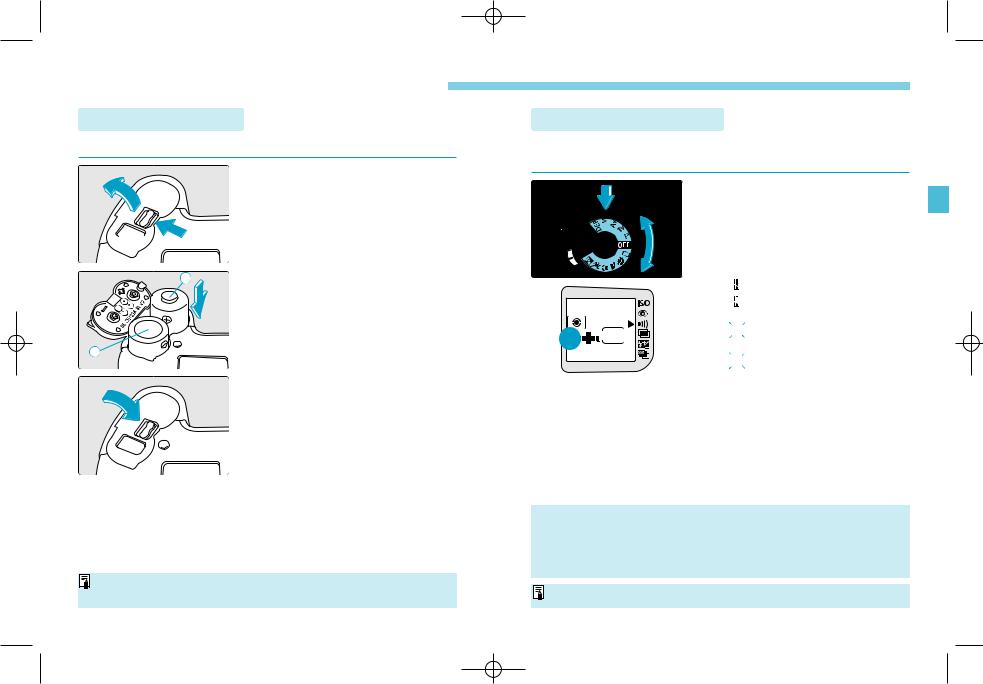
D33 K127 All.qxd 21-7-00 15:01 Page 18
Installing the Batteries and Checking the Battery Level
Installing the Batteries
(or DL123A) batteries.
1Open the battery chamber cover.
2

 1
1
+ |
2 |
• Make sure the battery contacts (+ |
|
||
|
and –) are oriented as shown on the |
|
|
|
battery chamber cover. |
|
|
• Do not mix old and new batteries. |
–
3Close the battery chamber cover.
• Press the cover until it snaps shut.
For places where CR123A batteries may not be easily available, take spare batteries with you. Also carry spare batteries for extended shooting sessions.
Installing the Batteries and Checking the Battery Level
Checking the Battery Level
Check the battery level after replacing the batteries and before using the camera.
the Command Dial to a -taking mode.
pressing the dial’s lock release while turning the dial.
camera will then turn on and the panel will display one of the
battery level icons:
level OK.
: The battery level is low. Keep spare batteries handy.


 : The batteries will soon be
: The batteries will soon be
completely exhausted.


 : Replace the batteries.
: Replace the batteries.  (®page 7)
(®page 7)
|
|
|
|
|
(With 24-ex. rolls) |
|
|
|
50% Flash Use |
100% Flash Use |
|
|
|
|
38 rolls |
19 rolls |
|
|
|
|
20 rolls |
10 rolls |
|
|
|
|
|
|
|
based on Canon’s testing lens and new batteries.
 • If nothing is displayed on the LCD panel, the batteries may have been installed incorrectly. Take out the batteries and install correctly. (®page 18)
• If nothing is displayed on the LCD panel, the batteries may have been installed incorrectly. Take out the batteries and install correctly. (®page 18)
•Pressing the shutter button halfway for a prolonged period or operating only the autofocus without taking a picture will still consume battery power. It will reduce the number of rolls that can be taken with the batteries.
Dial to <  >.
>.
18 |
19 |
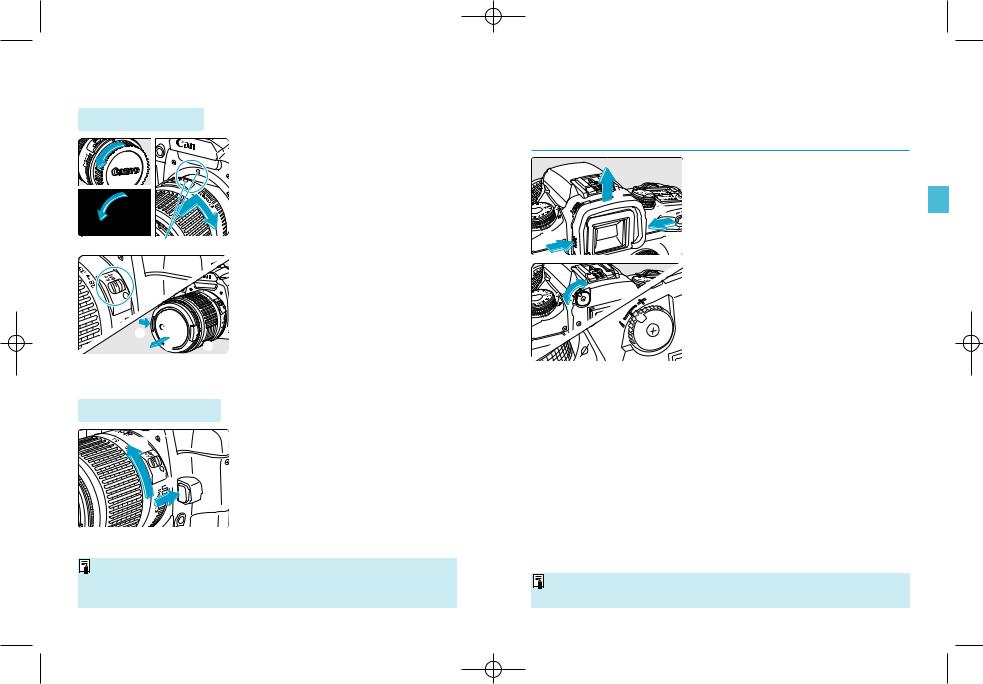
D33 K127 All.qxd 21-7-00 15:01 Page 20
Mounting and Detaching a Lens 
Mounting a Lens

 1
1
2 camera and turn the lens as shown
Mount the lens.
• Align the red dots on the lens and
by the arrow until it snaps in place.
3On the lens, set the focus mode
switch to <AF>.
• If the focus mode switch is set to
<MF> (or <M> on older lenses),
autofocus will not operate and <  >
>
 1
1 






 2
2 

Detaching the Lens
2 |
|
lens release |
|
as shown by |
|
|
|
|
|
1 |
the lens is at the |
|
|
you will not lose them.
Focus.
Dioptric Adjustment 
By adjusting the diopter, eyeglass wearers will not need their eyeglasses to see a sharp viewfinder image. The camera’s adjustable dioptric range is
–2.5 to +0.5 dpt.
1 |
Remove the eyecup. |
• While grasping both sides of the |
|
eyecup, slide it upward to remove. |
|
2 |
|
1 |
|
1
2Turn the dioptric adjustment knob.
• Turn the knob to the right or left until the focusing points look sharp in the viewfinder.
knob set at the standard diopter (–1 dpt).
3Reattach the eyecup.
If the viewfinder still does not look sharp after you turn the dioptric adjustment knob, use one of the Ed-series dioptric adjustment lenses (sold separately).
20 |
21 |
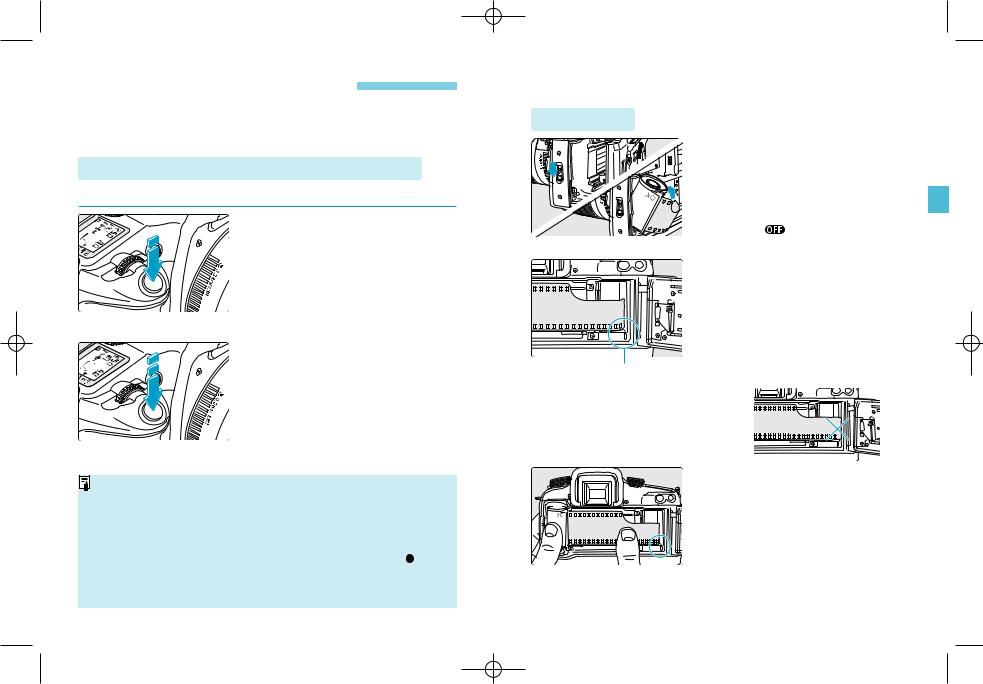
D33 K127 All.qxd 21-7-00 15:01 Page 22
How the Shutter Button Works
The EOS camera’s shutter button can be depressed halfway or all the way. There is a click stop at the halfway point.
Pressing the Shutter Button Halfway or Completely
The shutter button works as described below.
When it is pressed halfway:
• Autofocusing is activated, and when focus is achieved, the focusing point flashes and the beeper sounds. The in-focus indicator < > on the viewfinder’s lower right also lights.
> on the viewfinder’s lower right also lights.
• Also, the shutter speed and aperture are set and displayed on the LCD panel and in the viewfinder.
When it is pressed completely:
• The shutter is released to take the picture and the film advances by one frame.
• Camera movement during the moment of Camera shake can cause blurred pictures. To camera shake:
·Hold the camera steady (see page 26).
·Use the center of your finger to touch the with your entire right hand, then press the
• If the AF Mode Dial has been set to < 

 >, not light.
>, not light.
•If the AF Mode Dial has been set to < 

 > and automatic focusing point selection is set (®page 45), the focusing point will not flash in red.
> and automatic focusing point selection is set (®page 45), the focusing point will not flash in red.
 Loading and Unloading Film
Loading and Unloading Film 
Loading Film





 1 shown by the arrow.
1 shown by the arrow.
Open the camera back.
• Slide the camera back lever down as
2Insert the film cartridge at an angle as shown in the illustration.
• Set the Command Dial to any setting
|
except < |
>. |
3 |
Pull the edge of the film leader to |
|
the orange mark on the camera. |
||
• Hold down the film cartridge while |
||
pulling out the film leader.
• If the edge of the film leader goes beyond the orange mark, rewind some of the film back into the cartridge.
Wrong
4Close the camera back.
• After checking that the film leader
edge is correctly aligned with the
orange mark, close the camera back.
 The film will advance to frame 1
The film will advance to frame 1
automatically.
 When the initial film advance ends, the <
When the initial film advance ends, the < > icon and frame counter of “
> icon and frame counter of “  ” are displayed on the LCD panel.
” are displayed on the LCD panel.
22 |
23 |
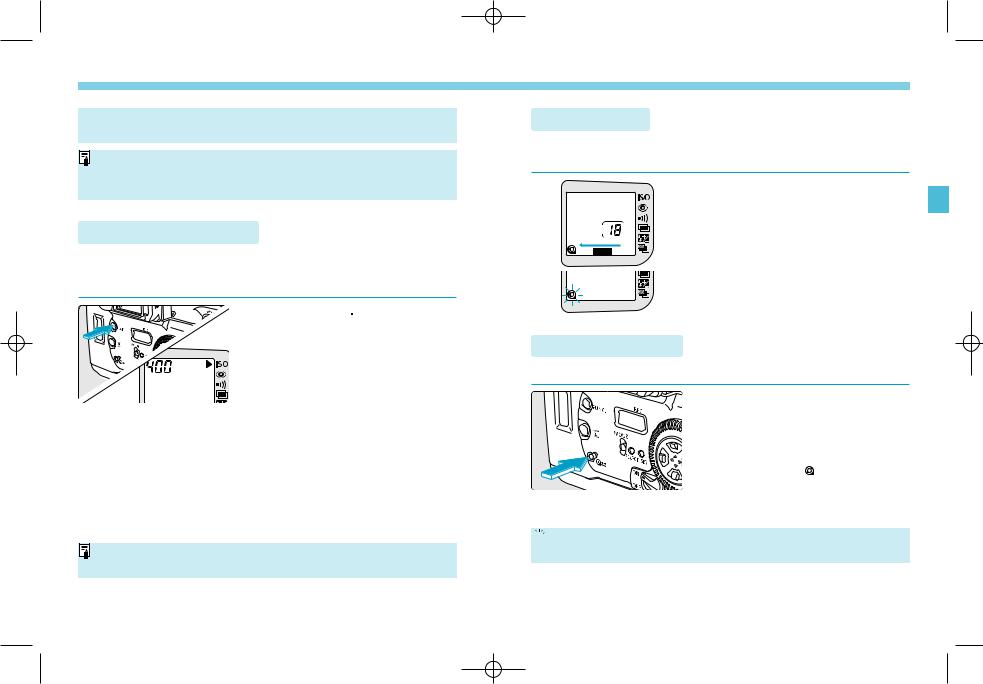
D33 K127 All.qxd 21-7-00 15:01 Page 24
 Loading and Unloading Film
Loading and Unloading Film
 In hot and humid environments, do not remove the film packaging until you are ready to load the film
In hot and humid environments, do not remove the film packaging until you are ready to load the film
• If the film is not loaded properly, the <  > icon will blink on the LCD panel and the shutter will not work. Reload the film cartridge properly.
> icon will blink on the LCD panel and the shutter will not work. Reload the film cartridge properly.
• Infrared film cannot be used with this camera.
Checking the Film Speed
The camera reads the film cartridge’s DX code and sets the film speed automatically within ISO 25 - 5000.
• Set the Command Dial to a Creative Zone mode.
Press the <
 > button and move the <
> button and move the < > arrow to <
> arrow to < 
 > on the LCD panel.
> on the LCD panel.
 The film speed will appear on the LCD panel.
The film speed will appear on the LCD panel.
If you want to set a film speed different from the DX-coded film speed or if the film cartridge is not DX-coded, see “Setting the ISO Film Speed” on page 71.
 C.Fn-3-1 can prevent the film speed from being set automatically with the DX code. (®page 88)
C.Fn-3-1 can prevent the film speed from being set automatically with the DX code. (®page 88)
 Loading and Unloading Film
Loading and Unloading Film
Unloading Film
After the film’s last frame is exposed, the camera rewinds the film automatically.
 When the film starts to rewind, the film advance indicator on the LCD panel will flow from right to left to indicate that the film is rewinding. The frame counter also counts down.
When the film starts to rewind, the film advance indicator on the LCD panel will flow from right to left to indicate that the film is rewinding. The frame counter also counts down.  The film rewind stops automatically. Check that the <
The film rewind stops automatically. Check that the < > icon on the LCD panel is blinking, then remove the film cartridge.
> icon on the LCD panel is blinking, then remove the film cartridge.

 Midroll Rewind
Midroll Rewind
the procedure below.
1Press the <
 > button.
> button.
 The film will start rewinding. The subsequent operation will then be the same as normal film rewind.
The film will start rewinding. The subsequent operation will then be the same as normal film rewind.
2 |
Take out the film cartridge. |
• Check that the < > icon on the LCD |
|
panel is blinking, then remove the |
film cartridge.

 During film rewind, pressing the <
During film rewind, pressing the <
 > button toggles between high-speed and low-speed (silent) rewind.
> button toggles between high-speed and low-speed (silent) rewind.
 Custom Function C.Fn-1 can alter the rewind speed. (®page 88)
Custom Function C.Fn-1 can alter the rewind speed. (®page 88)
 Normally, the entire film leader is rewound inside the film cartridge. Custom Function C.Fn-2-1 can leave out the film leader after film rewind. (®page 88)
Normally, the entire film leader is rewound inside the film cartridge. Custom Function C.Fn-2-1 can leave out the film leader after film rewind. (®page 88)
24 |
25 |
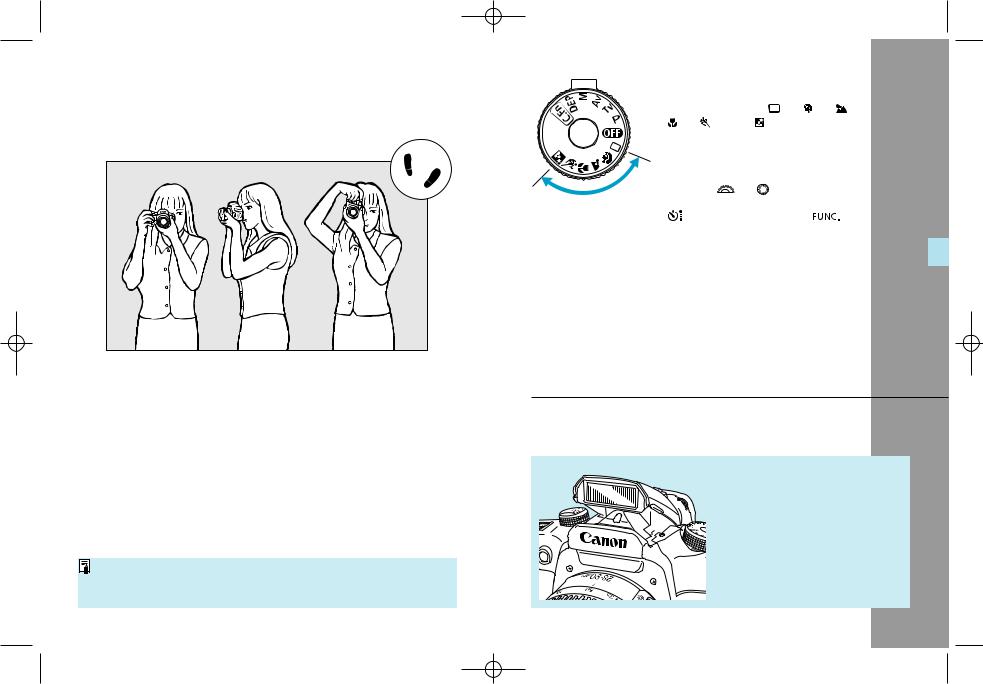
D33 K127 All.qxd 21-7-00 15:01 Page 26
Holding the Camera 
To avoid taking blurred pictures, hold the camera steady to minimize camera shake.
Horizontal shooting |
Vertical shooting |
•Firmly grasp the camera grip with your right hand, and press your right elbow lightly against your body.
•Hold the lens at the bottom with your left hand.
•Press the camera against your face and look through the viewfinder.
•To maintain a stable stance, place one foot in front of the other instead of lining up both feet.
The camera automatically senses whether it is in the horizontal or vertical position. When you switch between the horizontal and vertical orientations, the detection mechanism inside the camera will make a small sound.
For quick and easy picture-taking, this section describes the Command Dial’s
|
|
|
|
Basic Zone modes: < >, < >, < |
>, |
|
|
|
|
|
< >, < >, and < |
>. These modes |
|
|
|
|
|
set all the camera settings automatically. |
||
|
|
|
|
All you do is point the camera and press |
||
|
|
|
|
the shutter button. |
|
|
|
|
|
|
Also, these modes override the |
|
|
|
|
|
e |
camera’s < >, < |
>, and AF Mode |
|
|
|
n |
||||
|
o |
|
|
|
|
|
c |
Z |
|
|
|
|
|
Basi |
|
|
|
dials, film advance mode lever (except |
||
|
|
|
|
|||
|
|
|
|
< >), and buttons (except < |
>, |
|
2< 
 >, and the shutter button). This is
>, and the shutter button). This is
to prevent spoiled shots caused by accidental operation of camera controls.
Fully Automatic Shooting
•In the Basic Zone modes except <  > and <
> and <  >, the built-in flash pops up and fires automatically
>, the built-in flash pops up and fires automatically
under low-light or backlit conditions. (®page 74)
•The settings automatically set by the Basic Zone modes are shown in the “Feature Availability Table” on page 92.
26 |
27 |
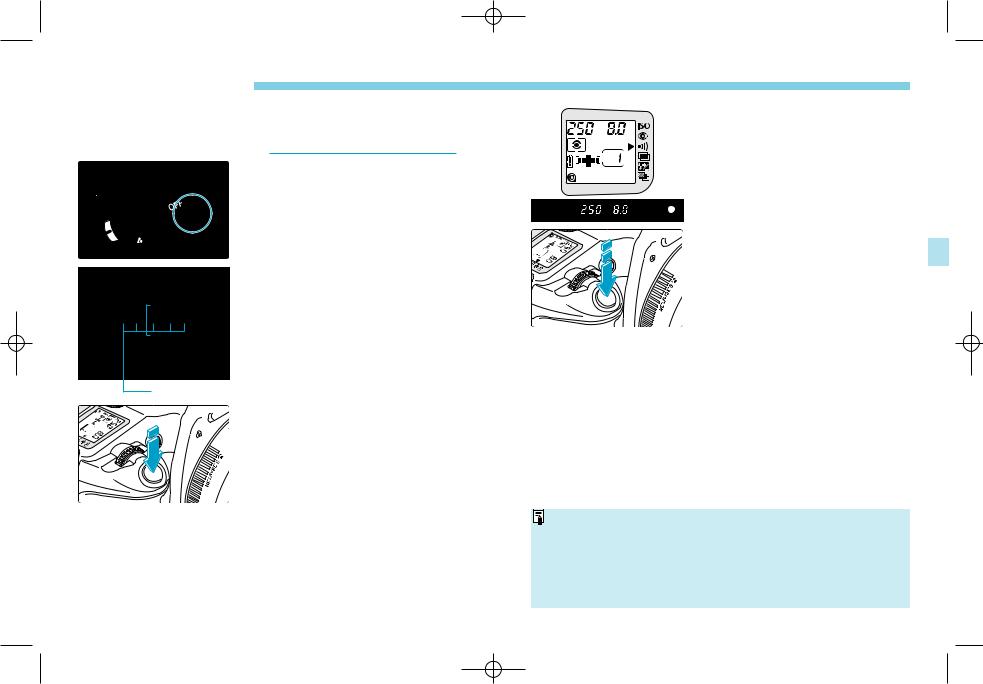
D33 K127 All.qxd 21-7-00 15:01 Page 28
 Full Auto Mode
Full Auto Mode
All you do is point the camera and press the shutter button. Everything is automatic so it is easy to photograph any subject. With seven focusing points to focus the subject, anyone can just point and shoot.
1Turn the Command Dial to < >.
>.
 This automatically sets the AF mode to <
This automatically sets the AF mode to <


 >, the film advance mode to <
>, the film advance mode to < > (single-frame shooting), and the metering mode to <
> (single-frame shooting), and the metering mode to < >.
>.
2Aim the focusing points on the subject.
 The main subject, as determined by the camera, will be focused by one of
The main subject, as determined by the camera, will be focused by one of
the focusing points.
• To focus a subject not covered by any of the focusing points, see “Focusing Off-Center Subjects” on page 47.
AF Frame
 3Press the shutter button halfway to focus.
3Press the shutter button halfway to focus.
 When focus is achieved, the focusing point which achieved focus will flash
When focus is achieved, the focusing point which achieved focus will flash
in red, the beeper will sound, and the
in-focus indicator < > in the viewfinder’s lower right will light.
> in the viewfinder’s lower right will light.
 Full Auto Mode
Full Auto Mode
4Check the exposure setting.
 The shutter speed and aperture will be set automatically and displayed in the viewfinder and on the LCD panel.
The shutter speed and aperture will be set automatically and displayed in the viewfinder and on the LCD panel.
 5Take the picture.
5Take the picture.
• Compose the shot and press the shutter button completely.
• When focus is achieved, the autofocus and auto exposure setting will also be locked.
• If the in-focus indicator <  > blinks, the picture cannot be taken. (®pages 48)
> blinks, the picture cannot be taken. (®pages 48)
•Out of the seven focusing points, the one covering the closest subject is selected automatically to achieve focus.
•Multiple focusing points may light simultaneously. This indicates that these focusing points have all achieved focus.
28 |
29 |
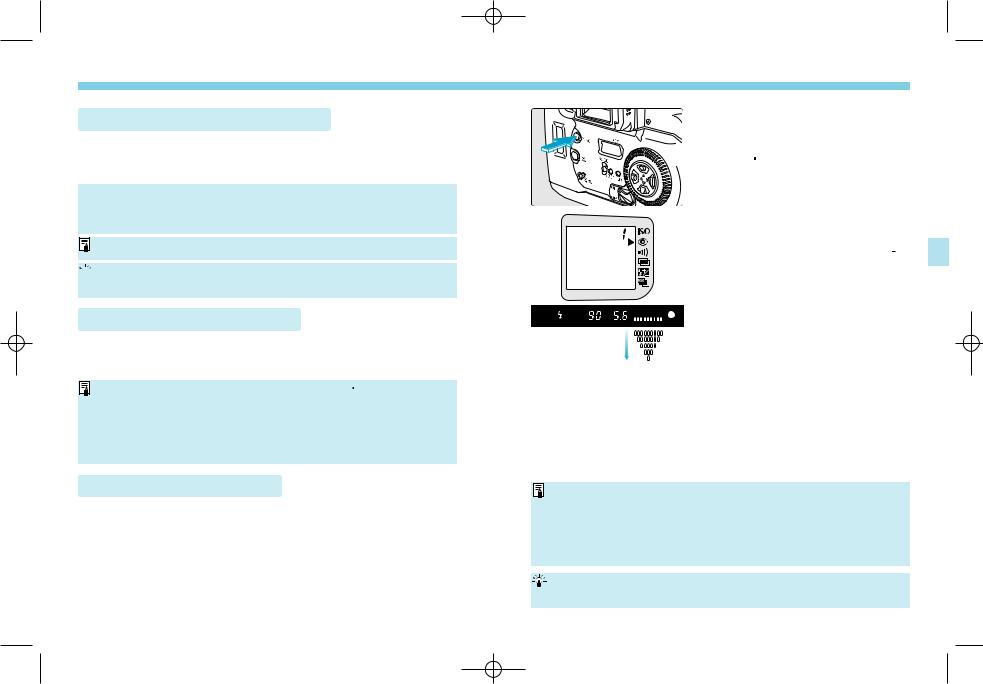
D33 K127 All.qxd 21-7-00 15:01 Page 30
 Full Auto Mode
Full Auto Mode
Automatic Firing of the Built-in Flash
In the Basic Zone modes (except <  > and <
> and <  >), the built-in flash pops up and fires automatically under low-light or backlit conditions. (To retract the flash head, push it down by hand.)
>), the built-in flash pops up and fires automatically under low-light or backlit conditions. (To retract the flash head, push it down by hand.)
 If the built-in flash’s automatic pop-up action is obstructed accidentally, the <
If the built-in flash’s automatic pop-up action is obstructed accidentally, the <  > icon will blink on the LCD panel as a warning. If this happens, press the shutter button halfway to return the camera to normal operation.
> icon will blink on the LCD panel as a warning. If this happens, press the shutter button halfway to return the camera to normal operation.
Also read the cautions for using the built-in flash on pages 74.


 If you do not want the built-in flash to fire, use the <
If you do not want the built-in flash to fire, use the <  > (Program AE) mode. (®page 52)
> (Program AE) mode. (®page 52)
AF-Assist with the Built-in Flash
Under low-light conditions, the built-in flash fires a brief burst of flashes when you press the shutter button halfway. This is to illuminate the subject (AF assist light) to enable easier autofocusing.
• The AF-assist light does not function in the <  > and <
> and <  > modes.
> modes.
•The built-in flash’s AF-assist light is effective up to about 4 meters.
•In a Creative Zone mode, lift up the flash head and the AF-assist light will be emitted when necessary.
•When an EOS-dedicated Speedlite is attached to the camera, the Speedlite’s built-in AF-assist lamp will light.
 Using Red-eye Reduction
Using Red-eye Reduction
When flash is used in a low-light environment, the subject’s eyes may come out red in the photograph. “Red eye” happens when the light from the flash reflects off the retina of the eyes.
The camera’s red-eye reduction feature turns on the red-eye reduction lamp to shine a gentle light into the subject’s eyes to narrow the pupil diameter or iris. A smaller pupil reduces the chances of red eye from occurring. Red-eye reduction can be set in any picture-taking mode except <  > and <
> and <  >.
>.
 Full Auto Mode
Full Auto Mode
 1Move the <
1Move the < > arrow to the <
> arrow to the < > icon on the LCD panel.
> icon on the LCD panel.
•Look at the LCD panel and press the < 
 > button to move the arrow.
> button to move the arrow.
(  )
)
2Turn the < > dial to set “
> dial to set “  ” on the LCD panel.
” on the LCD panel.
Red-eye reduction lamp-on indicator
•To cancel red-eye reduction, set “
 ” on the LCD panel.
” on the LCD panel.
•Press the shutter button halfway to return to normal camera operation.
•When red-eye reduction is enabled, the red-eye reduction lamp-on indicator will be displayed in the viewfinder and on the LCD panel when you press the shutter button halfway and the lamp lights.
unless the subject looks at the red-eye to look at the lamp.
the picture after the red-eye reduction lamp
the red-eye reduction lamp is lit. reduction varies depending on the subject.
of red-eye reduction, go to a brighter the subject.
31
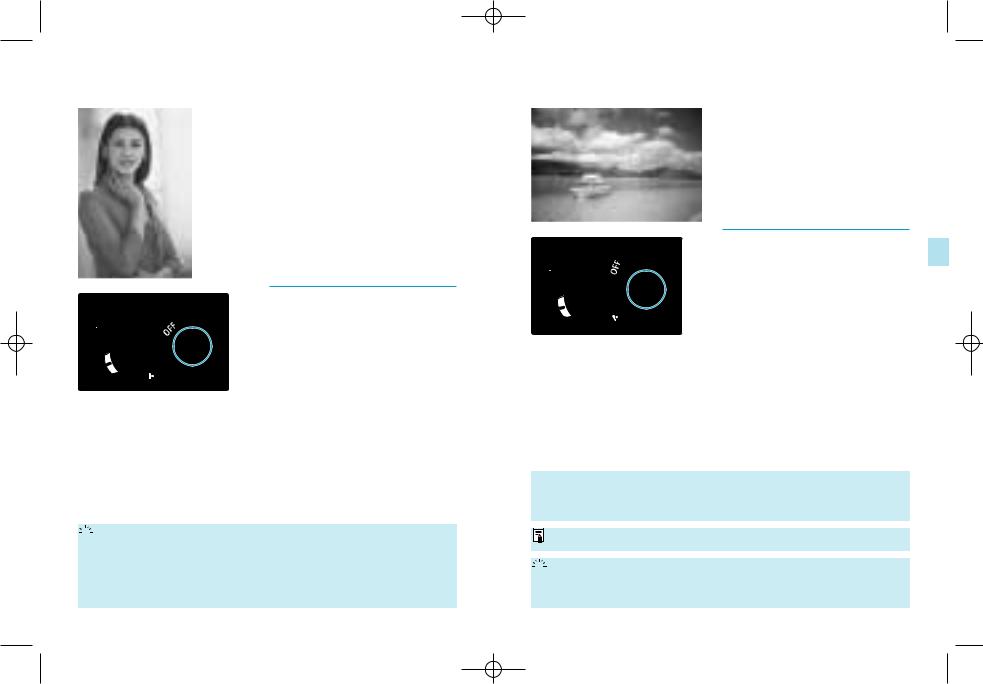
D33 K127 All.qxd 21-7-00 15:01 Page 32
 Portrait Mode
Portrait Mode 
This mode blurs the background to make the human subject stand out.
Turn the Command Dial to < >.
>.
• The picture-taking procedure is the same as with the < > Full Auto mode on page 28.
> Full Auto mode on page 28.
 This automatically sets the AF mode to <
This automatically sets the AF mode to < 

 >, the film advance mode to <
>, the film advance mode to <  >, and the metering mode to
>, and the metering mode to
<  >.
>.


 • Background blur is most effective when the subject fills the frame from the waist up. Also, the further away the subject is from the background, the more blurred the background will become.
• Background blur is most effective when the subject fills the frame from the waist up. Also, the further away the subject is from the background, the more blurred the background will become.
•Using a telephoto lens also increases background blur. If you have a zoom lens, use the longest focal length. (For example, a 28-90 mm zoom lens set to 90 mm.)
 Landscape Mode
Landscape Mode 
This is for sweeping scenery, night scenes, etc.
Turn the Command Dial to < >.
>.
• The picture-taking procedure is the same as with the <  > Full Auto mode on page 28.
> Full Auto mode on page 28.
 This automatically sets the AF mode to <
This automatically sets the AF mode to < 
 >, the film advance mode to <
>, the film advance mode to <  > (single-frame shooting), and the metering mode to <
> (single-frame shooting), and the metering mode to <  >.
>.
 If the shutter speed display blinks, the shutter speed may be too slow and a blurred picture may result due to camera shake. Using a tripod is recommended. (The shutter speed will still blink even while a tripod is used.)
If the shutter speed display blinks, the shutter speed may be too slow and a blurred picture may result due to camera shake. Using a tripod is recommended. (The shutter speed will still blink even while a tripod is used.)
The built-in flash will not fire in this mode even while it is popped up.


 Using a wide-angle lens will further enhance the depth and breadth of the picture. If you have a zoom lens, use the shortest focal length. (For example, a 28-90 mm zoom lens set to 28 mm.)
Using a wide-angle lens will further enhance the depth and breadth of the picture. If you have a zoom lens, use the shortest focal length. (For example, a 28-90 mm zoom lens set to 28 mm.)
32 |
33 |
